Intel Broadwell Architecture Preview: A Glimpse into Core M
by Ryan Smith on August 11, 2014 12:01 PM ESTPutting It All Together: Low Power Core M
So far we’ve discussed Broadwell’s architecture on a broad basis, focusing on features and optimizations that are fundamental to the architecture. However to talk about the Broadwell architecture is not enough to fully explain the Core M itself. Though many of Core M’s improvements do come from Broadwell, Intel has also made a number of alterations to everything from the CPU packaging to the process node itself specifically for Core M. It’s the resulting combination of these factors that has allowed Intel to iterate on Broadwell-Y over Haswell-Y, and why Intel is so confident in Broadwell-Y’s capabilities and suitability for mobile form factors.
When it comes to building and configuring Core M, Intel likes to refer to their efforts as the “Fanless Challenge,” reflecting the fact that their biggest goal with Core M is to comfortably get the processor in to 10” tablets under 10mm in thickness that are passively cooled. A big part of getting into such a device is meeting the heat dissipation limitations of the form factor – a 10” tablet under 10mm would require a sub-5W SoC – which is where a lot of Intel’s engineering efforts have gone. Broadwell’s performance optimizations, the GPU optimizations, GPU duty cycling, and the 14nm process all contribute to getting a Core CPU’s power consumption down to that level.
But even that’s still not enough, and for Core M Intel went so far as to give Broadwell-Y its own die and design a low-power optimized version of their 14nm process just for it. This variant is designed to further reduce power consumption by optimizing the resulting transistors for lower power, lower voltage, lower clockspeed operation. By doing this Intel was able to further reduce power consumption in all of the major areas over what would be a traditional 14nm Intel process.
In the resulting 14nm Broadwell-Y process, voltage, capacitance, and leakage were all improved over the traditional 14nm process. Capacitance was reduced by 15%, minimum operating voltages by 10%, and leakage was improved to the point that it reduced SoC power consumption by 10%. The combination of all of these factors serves to significantly lower power consumption over what Intel’s traditional 14nm process would provide.
Working in concert with Broadwell-Y’s 14nm process, Intel has made a number of other changes to further reduce power consumption. Some of these are reflected in Broadwell’s overall design and others are unique to Broadwell-Y, such as using a lower TjMax for Broadwell-Y. By reducing the maximum operating temperature of the chip Intel has been able to realize further power savings by further reducing voltage and decreasing the maximum amount of temperature-dependent leakage the SoC will experience.
Meanwhile Broadwell-Y’s partner in crime, the on-package PCH, has received its own optimizations to reduce power consumption on the SoC’s total power consumption. The PCH itself is not much of a power hog in the first place – it’s still made on Intel’s 32nm process for this and cost reasons – but with such a strong focus on power consumption every watt ends up counting. As a result the Broadwell PCH-LP has seen optimizations that cut its idle power consumption by 25% and its active power consumption by 20%. Further improvements to the PCH’s monitoring hardware also mean it’s more responsive and can be controlled to a finer degree than the Haswell PCH-LP, and Intel has upgraded to a faster audio DSP to improve performance and reduce power consumption there as well.
Feeding all of that silicon in turn is Intel’s second generation Fully Integrated Voltage Regulator (FIVR), which further builds off of Intel’s other optimizations. The 2nd gen FIVR has been tuned for Broadwell-Y’s lower voltages, making the FIVR itself more efficient when delivering power at those voltages. To accomplish this Intel has implemented non-linear vDroop control, which is designed to better control the voltage when workload changes would cause voltage overshoots that waste power. And when even the 2nd gen FIVR isn’t efficient enough, this latest FIVR offers a second mode (LVR Mode) for low voltage/workload situations where the FIVR can be partially bypassed to reduce the FIVR’s power consumption.
Interestingly Broadwell-Y also sees the voltage regulation inductors redesigned and relocated in both the name of power efficiency and space efficiency. We’ll get to the case of space efficiency in a moment, but for power efficiency the new 3D inductors (3DLs) have been placed on the underside of the package, allowing the use of more efficient inductors that waste less power.
This brings us to the final element of Intel’s power optimization efforts, which involve further adjustments to turbo boost as part of Intel’s “hurry up and go to sleep” motto. New for Broadwell-Y is a 3rd power state, PL3, which allows for even greater turbo boosting, but for only a very limited period of time – on the order of milliseconds. PL3 represents the maximum amount of power the device battery can deliver, and while it’s okay to reach this value sparingly, PL3 is a fast drain that is very hard on the battery. The existence of PL3 in this case is as much for battery protection as it is for performance; it allows devices to tap into PL3 power levels on occasion, all the while allowing PL2 (the regular burst limit) to be defined at a safer value below the battery’s limit. Put another way, by knowing PL3 devices know how to stay farther away from it, which in the long run is what’s best for battery reliability.


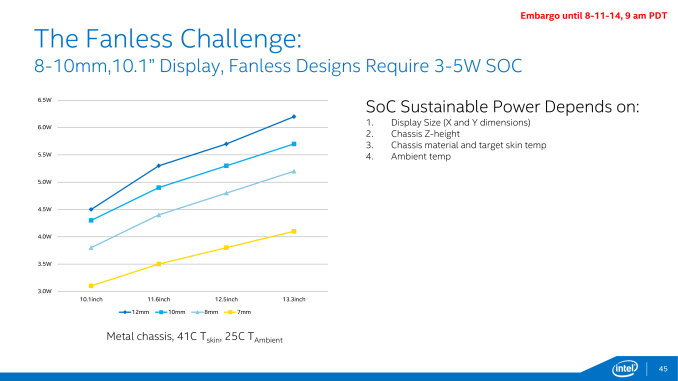
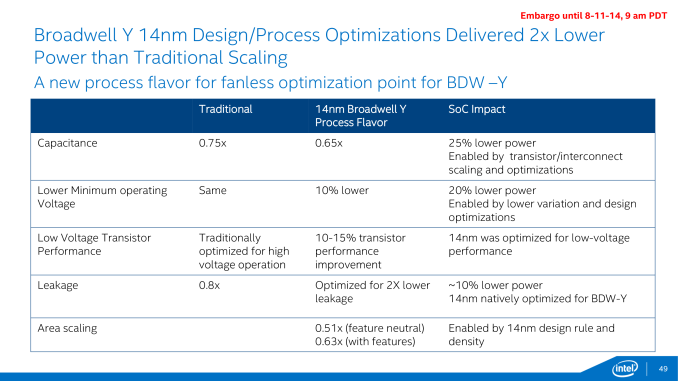
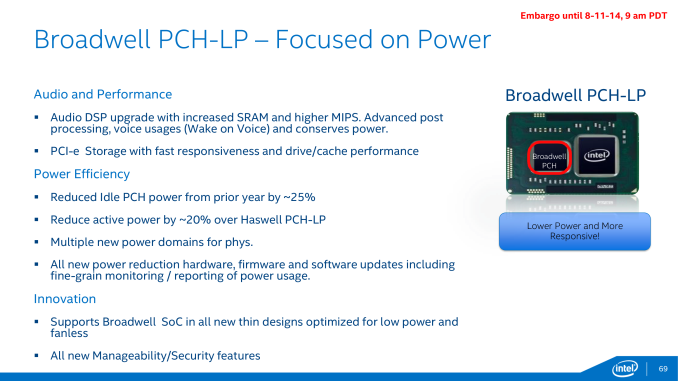
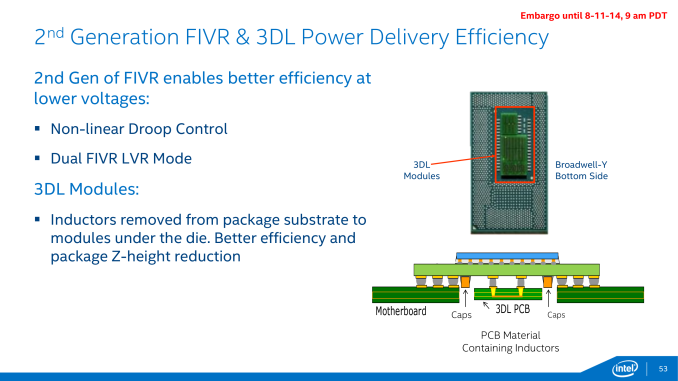

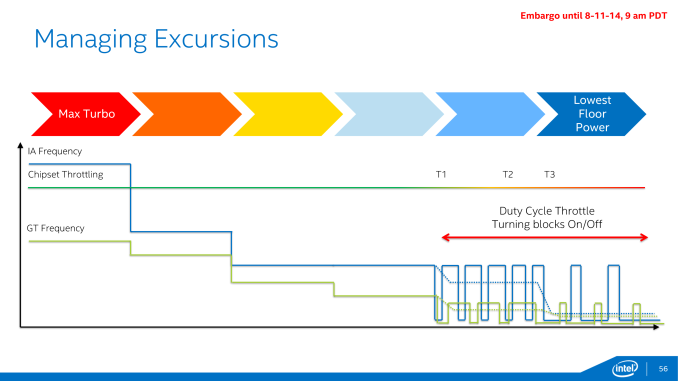








158 Comments
View All Comments
AnnonymousCoward - Tuesday, August 12, 2014 - link
You should look at discrete graphics HW sales.tuxRoller - Tuesday, August 12, 2014 - link
Nvidia, which has around 60% of the discrete gpu market, has a yearly revenue of around $4 000 000 000. So, you're looking at a total market of around $7 000 000 000.Johnmcl7 - Tuesday, August 12, 2014 - link
"Maybe not obsess, but to characterise the PC gaming market as ridiculously small, is pretty far off the mark...."I think the original comment was fairly accurate, even in the PC gaming market there's a large proportion of people using Intel graphics cards. Looking at the current Steam survey results, 75% are using Intel processors and 20% overall are using Intel graphics which means around 1 in 3 people with Intel processors on Steam are using the onboard graphics card. The means even among the gaming market there's a lot of integrated cards in use and that's just one small portion as I'd expect most other areas to mainly be using integrated cards.
There are workstation graphics cards but professionals using those are unlikely to be using consumer processors and the enthusiast/workstation processors do not have an integrated graphics card.
zepi - Tuesday, August 12, 2014 - link
I have had steam on my company laptop with just internal GPU just to take part into the sales campains etc. This makes my contribution to 50:50 in terms on dGPU / iGPU, even though 100% of gaming happens with dGPU.AnnonymousCoward - Tuesday, August 12, 2014 - link
So....how do NVIDIA and ATI stay in business? Obviously many people use discrete cards. The fact you say "obsess" tells me you probably don't realize the massive performance difference, and it's not limited to gaming. CAD uses 3D.AnnonymousCoward - Wednesday, August 13, 2014 - link
Doesn't Intel make X-version CPUs that can be overclocked? The OC market is gonna be much smaller than dGPU, and they're already making a dedicated product for that.Krysto - Tuesday, August 12, 2014 - link
Because they are using that anti-competitive tactic to drive out the discrete competition. They force OEMs to buy them bundled, so more and more people say "why should I pay twice for the GPU...I'll just get the Intel one".It's a nasty tactic, Intel has been employing for years, and unfortunately it's working. But it's terribly uncompetitive.
Krysto - Tuesday, August 12, 2014 - link
It's akin to Microsoft bundling IE with Windows "Why would I need to get another browser...I'll just use IE". That tactic WORKED for Microsoft. It only stopped working when they became lazy. But they could've hold the 90 percent market share of IE for a lot longer, if they didn't get lazy.AnnonymousCoward - Tuesday, August 12, 2014 - link
I dunno--anyone who plans to get a discrete card is going to get one, regardless of Intel forcing it onto the CPU.I wonder what percent of the desktop die will be GPU. Maybe with the GPU disabled, the CPU turbo will work better since there will be less heat.
name99 - Tuesday, August 12, 2014 - link
"we’ll still have to wait to see just how good the resulting retail products are, but there shouldn’t be any technical reason for why it can’t be put into a mobile device comparable to today’s 10”+ tablets. "There may not be TECHNICAL reasons, but there are very definite economic reasons.
People think of tablets as cheap devices --- iPad at the high end, but the mass market at $350 or so. This CPU alone will probably cost around $300. MS is willing to pay that for Surface Pro 4; no-one else is, not for a product where x86 compatibility is not essential.
We'll see it in ultrabooks (and various ultrabook perversions that bend or slide or pop into some sort of tablet) but we're not going to see a wave of sub<$1000 products using this.